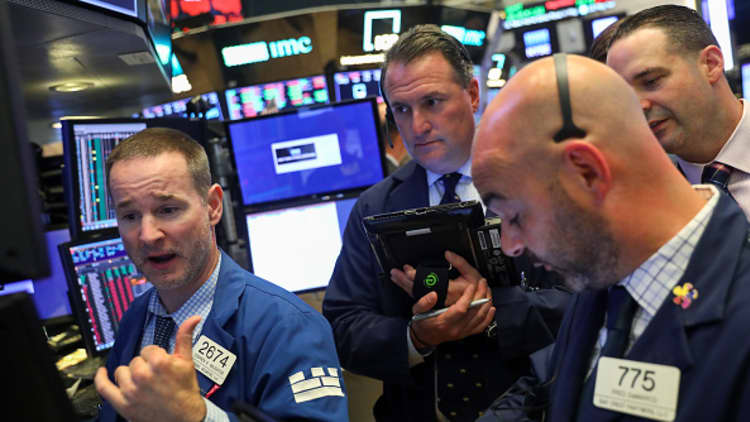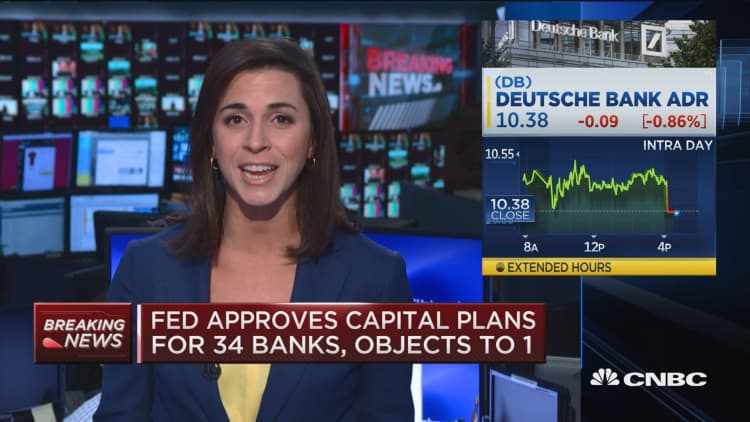
Goldman Sachs and Morgan Stanley were forced to leave shareholder payouts at roughly last year’s level after fumbling a crucial part of the Federal Reserve’s annual stress test, while competitors from J.P. Morgan Chase to Citigroup were allowed to boost distributions.
The New York-based investment banks were ensnared by the administration’s tax cut, which resulted in a one-time drop in the capital ratios of the firms, according to the Federal Reserve. Specifically, when accounting for the dividends and buybacks the firms originally wanted to pay, the banks fell beneath minimum required ratios for capital levels called tier 1 leverage and supplementary leverage under a scenario of financial distress.
As a result, regulators gave them conditional non-objections to their subdued capital plans — but stopped short of failing them because of the one-time nature of the tax charge, according to a briefing with reporters. Keeping the total amount of their payouts at the same level as last year will enable the firms to build a larger cushion for next year.
Shares of Goldman and Morgan fell briefly in early trading Friday despite a broad rally in financial stocks. Goldman and Morgan were up less than 0.3 percent while Wells Fargo advanced 5.4 percent at 10:05 a.m.
Before last week’s red flag, analysts and investors had reason to believe the banks could raise their total payouts. The industry has been recovering, increasing earnings to a record in the first quarter.
Instead, Goldman Sachs said it would return no more than $6.3 billion in capital in the year starting in the third quarter. It is raising its dividend 5 cents to 85 cents a share, but that doesn't kick in until next year's second quarter. Morgan Stanley said it would distribute an amount consistent with the $6.8 billion it gave out last year, including raising its dividend by 5 cents to 30 cents a share beginning in the third quarter this year.
"Morgan Stanley was definitely a disappointment on the buyback, and Goldman was on the low end of the range I was expecting," said Charlie Peabody, analyst at Portales Partners.
Even though the companies said they would raise their dividends, the payouts are lower than expectations, Peabody said. Morgan Stanley's annual $1.20 a share dividend compares with expectations for $1.24, and Goldman's $3.20 a share dividend compares with expectations for $3.36.
After the two banks squeaked by the initial version of the test last week, they both issued public statements indicating confidence they could return more capital to shareholders than the regulators’ figures suggested. “Our models and the Federal Reserve’s models diverge, which we expect to discuss with the Federal Reserve,” Goldman said at the time.
In the annual ritual, banks must show that they can survive an economic downturn with enough capital to keep lending, while taking into account the capital leaving in the form of dividends and share repurchases. Capital, the difference between a bank’s assets and liabilities, is the cushion banks use to absorb unexpected losses. The 2018 version used one of the most severe hypothetical economic scenarios since starting the tests in 2009. It assumed unemployment at 10 percent, losses in corporate and real estate loans, and difficult conditions overseas.
After the tax overhaul was announced late last year, Goldman Sachs said earnings were taking a $5 billion hit, mostly tied to a bill from repatriating earnings. Morgan Stanley took a $1.4 billion hit because of the lowered value of deferred tax assets.
Another bank, Boston-based State Street, also got a conditional non-objection. It has to take steps to improve its management of counterparty risk under stressful scenarios.
But the Fed saved its worst grade for the U.S. division of Deutsche Bank, which the Fed has previously deemed a troubled institution. The Fed said it objected to the capital plan of DB USA over concerns about the firm’s management of data and its capital planning and weaknesses in forecasting revenues and losses. U.S. shares of Deutsche Bank fell about 1 percent in extended trading Thursday.
The banks can also resubmit their capital plans before next year’s tests to request more payouts, the Fed noted.
While 35 banks were included in this year’s stress test, only 18 of the biggest and most complex institutions had to go through both qualitative and quantitative parts of the exam.
Of those, 15 firms won a clear thumbs up from the Fed and will be allowed to proceed with their planned pay-outs, which could include hikes in dividends and buybacks. So banks from J.P. Morgan Chase to Bank of America should be able to proceed as their executives have planned. That also includes Wells Fargo, which analysts had speculated could be dogged by its misconduct issues for the qualitative part of the exam.
“Even with one-time challenges posed by changes to the tax law, the CCAR results demonstrate that the largest banks have strong capital levels, and after making their approved capital distributions, would retain their ability to lend even in a severe recession,” said Fed Vice Chairman Randal Quarles.
Big banks have more than doubled their capital levels since the financial crisis, thanks in part to greater supervision including the annual stress tests. Still, bank executives have complained publicly that they now hold too much capital, restraining their ability to increase pay-outs.
WATCH: Stress test results



